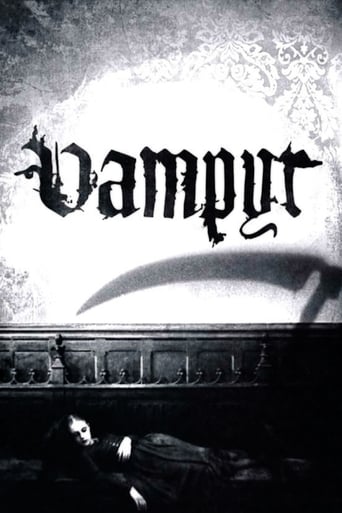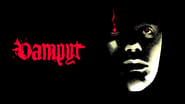Antonius Block
This version of the vampire genre is a bit different and slow in developing, but makes up for it with its dreamlike feel, which is dark, stylish, and atmospheric. Stick with it if you get impatient early on. Director Carl Theodor Dreyer conveys eeriness and satanic danger which is sometimes a little hard to follow, kind of like a nightmare, but helps us understand what's happening through shots on the pages of an old book, left after a man is killed. Reality is warped and this effect is heightened by his use of light and shadows, his use of soft focus, and frankly, the film's age and restored condition. In some way, the film is a bit like 'Blair Witch Project' in how stripped down it is plot-wise, but it's far more artistic, with surreal and expressionist overtones. If you're looking for action and the classic types of vampire scenes, you'll probably want to skip this one.I did have some issues with the pace, but there are some fantastic moments (careful, possible spoiler alert): the tortured look on the daughter's face, as she knows she's damned; the shadow separating from its body; the vision of being put into a coffin, with the camera angle through the window; and lastly, the scene in the mill at the end, where the gears turn to slowly start burying the village doctor. How fitting is it that the hero drifts off in a boat, as if rowing out of an awful dream. This one will grow on you, and is particularly impressive for having been made in 1932.
Hunter Jelf
Allan Gray is a young traveler obsessed with studying the occult and vampires. During his travels he comes to an small inn in the village of Courtempierre and stays for the night. During the night he is visited by a mysterious man who talks of a young dying woman and leaves Gray a package saying that it should "be opened in the event of my death". Gray, feeling a foreboding doom, heads out and finds himself amongst the horrors of the supernatural. So sets up Carl Theodore Dryer's 1932 horror film, "Vampyr". "Vampyr" is a hard film to talk about because of how strange it is. After I saw it for the first time I was completely baffled. I didn't know what to make of it and I couldn't make sense of what I had just seen. In structure, it is a very unorthodox movie. Shot and edited together in a very bizarre manner. The story is told in a linear fashion but the viewer is required to fend for themselves for much of it. Bridging shots and connecting sequences are almost entirely absent, much of what hear occurs off-screen, and what we do get to see is almost always unexplained. It makes for a really bizarre viewing experience. Despite that, the movie never feels disjointed, it has its own flow that feels as natural to the story as it is unorthodox.What this bizarre flow does for the film is it gives one of the creepiest and chilling horror films from the era. The way the story is told is like that of a nightmare. Nothing is ever certain, shadows bend and play at their will, backgrounds ever so subtly seem to twist and contort, and the evil waits and festers out of sight, but not out of mind. This can be attributed to the film's aesthetic design. Much of the film was shoot on overexposed stock so it has a washed out soft look making it seem as though it is a nightmare. The effects with shadows moving with no physical bodies are some of the finest and most chilling effects from any horror film. Much should be given to the sound design for helping make this movie as creepy as it is. The film was made in 1931, released in '32, so it was a very early talkie. Unlike many films from that period, "Vampyr", features almost no dialogue and makes itself look like the silent horror films. Most of the sound is in the film's score and sound effects, most of which are distorted or off-screen. The score in particular is very good and creepy. It's nice to have when considering many early talkies like the 1931 "Dracula" really didn't have a score. It has an unconventional sound and is major player in the film's nightmarish tone and keeping the story from feeling disjointed. Dialogue is held to a hardcore minimum, shows up very rarely and not for very long. Again, like silent films information is given via inter-titles or as it is later in the film, from the pages of a book.Some people may be turned off by the acting in the film. Most of the stars were not professional actors and some, including lead actor Julian West, only have "Vampyr" to their credit. West spends most of this film in an almost emotionless apathetic state to what is going on. Everyone else puts on more emoted performances but they're subdued and it makes the characters seem more like the vignettes of a nightmare than actual people. Dryer makes good use of it though. The skewered perspectives and strange compositions make the acting effective and additive to the movie's horror."Vampyr" is, at the end of the day, a very creepy and bizarre experience. You should totally watch it now. Do not miss this under-appreciated classic, especially if you are a fan of horror from the 1920s and 30s. Alternate recommendations include F.W. Murnau's "Nosferatu" from 1922 and Tod Browning's "Dracula" from 1931. Both are great vampire movies from the same time period and serve as good entry points into the world of 20s and 30s horror.
kurosawakira
Liminal, evasive; a cinematic tone poem of light and shadow; the vertex of the ideas of the so-called German expressionist movement; a memento mori; wildly unpolished; a rumination on the fantastical in cinema and ultimately, even on the sacrifice of Christ (as pointed out by Guillermo del Toro on the commentary track available on the Masters of Cinema DVD) — this is Dreyer at his most experimental, adventurous, hallucinatory, and his best. As its German subtitle suggests, this film is a dreamworld not only free of expectations of conventional narrative, it's adventurously lyrical and purely cinematic in its cogitation.The film exists in the atmosphere. By this I don't mean the banal idea that atmosphere is only a stylistic device separate from the plot but instead that atmosphere is the fabric of cinematic experience and narrative. Had Dreyer done no other films at all, I would rank him among the greatest based on this film alone: the eye is remarkably dimensional, moving spatially and lucidly, shocking considering the medium was only some 30 years old at the time. The editing is disconcerting, and in the words of Tony Rayns, "this is cutting that has no rational explanation. These shots are not commenting on each other, they don't materially implicate each other in any conceptual way at all, they simply add a certain rhythm, a certain tone to the film as a whole." It has a marvelous effect on the viewer: we know the elementary story but the way it presents itself is so delirious we're in constant stupefaction because the film evades our formal expectation. No wonder why the film was badly received during the Berlin premiere in 1932 — it's a free film, not adhering to prevailing norms of form and narrative, springing from a film tradition but swerving, ever swerving from the customary orbit.The most frightening images in the film are the ones that are burnt in the memory, take on a new shape in our minds and feed on our nostalgia; whereas the real vampire in the film is time, it's the images themselves that live off this symbiotic existence.I would love to know whether Mizoguchi saw this film or not — the scene toward the end in the fog at the lake is reproduced in "Ugetsu monogatari" (1953) to a startling effect.
kfo9494
After reading all the reviews on this film, I considered it a 'must watch' event. However, I can honestly say that I was not as impressed as others.The story was good, the action was great and the feeling of horror was extreme. But I found the film hard to follow.It seemed that Allan Grey was going from one situation to another without explanation. One scene he is in an inn and the next scene he appeared to be following shadows in another building. He sat on a bench and the next thing we see is an out-of-body experience that seemed to be crucial but we are not sure of the reason.Carl T Dreyer, in my opinion, is one of the best directors in early cinema. But this film appears that he might have been holding onto the 'old-ways' too long. By 1932, films had somewhat good sound and the use of lighting excellent. But this film, or at least the copy I saw, reverses all the tends of film making. The appearance of the film felt more like 1922 than 1932.The film does stir strong emotions of evil and doom. The camera is used to let the viewer feel like they are part of the events on the screen. But at times we have to guess at the event.It's a good film and an fair watch. But be prepared to say "What just happened" during parts of the movie.



